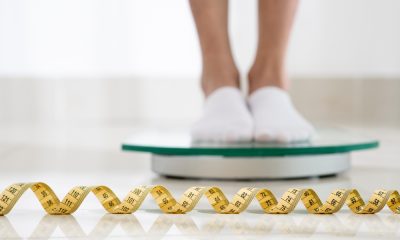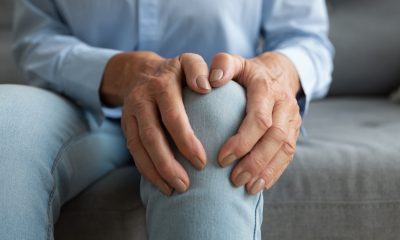Mobility
Scotland warned over housing shortfall for older people

Scotland’s ageing population will soon outpace its housing provision, with 70 per cent of homes failing to meet the needs of older residents, a new report has warned.
In 20 years, more than a quarter of Scotland’s population will be aged 65 or over, while those under 16 are projected to make up just 13.3 per cent – highlighting the growing need for accessible housing.
Despite mounting pressure, the Scottish Government’s accessible housing working group has not met since 2021.
Many homes were built before 1982 and are considered unfit for the needs of older and disabled people.
The Scottish Federation of Housing Associations (SFHA) is calling on MSPs to develop a national strategy for housing elderly and disabled people. It warned that continued inaction will worsen inequalities and put further strain on the NHS and social care.
Susie Fitton, policy manager at the SFHA and author of the report, said: “The devastating impact of Scotland’s housing emergency is well documented.
“We desperately need more homes being built, but we need to be strategic about the design of these homes to ensure they will serve the needs of people as they age.
“Most of our current housing stock was designed for a previous century and we must update our approach.
“Across Scotland there are around 78,000 people we currently know need an adaptation to live independently in their home. The real number is likely to be higher and it will only climb as our population gets older.
“We want to see a national accessible housing strategy. Policymakers must ensure that the funding and systems in place for delivering adaptations are significantly improved to meet the need.”
The Homes Fit For The Future report recommends that all newbuild homes, across all housing types, should follow a common accessibility standard to ensure they are suitable from the start.
SFHA estimates that around 78,000 people in Scotland currently need adaptations to live independently.
It believes the true number is likely to be higher and will increase significantly as the population ages.
Fitton said adopting a common design standard from the day homes are built is the most effective way to ensure Scotland’s housing is fit for the future.
The report also calls for investment in assistive technologies such as fall-detection sensors, voice-enabled companions and digital applications, which can support independent living, reduce injuries and help avoid hospital admissions.
Fitton added: “Meeting the needs of our ageing population will require radical and innovative solutions, which includes embracing technological change.
“Given technology can allow people to live independently and prevent injuries and hospital admissions, then policymakers must ensure social housing grant levels are enough to invest in such preventative technology from the outset when building new homes.”
News
Cycling may lower dementia risk, study finds

Cycling instead of driving or taking public transport is linked to a 19 per cent lower risk of developing dementia.
An analysis of nearly 480,000 people in Great Britain also found regular cyclists had a 22 per cent lower risk of Alzheimer’s disease compared with those using cars, buses or trains.
More than 55m people worldwide currently live with dementia, with numbers predicted to almost triple by 2050.
Physical activity has been identified as one of 14 factors that could prevent or delay about 45 per cent of cases.
Researchers from the UK Biobank study tracked the health of more than 500,000 people aged 40 to 69, recruited between 2006 and 2010.
Participants, who were aged 56.5 on average, answered questionnaires about which transport modes they used most often for non-work journeys.
Over a median follow-up of 13.1 years, 8,845 developed dementia and 3,956 developed Alzheimer’s disease.
The study examined nonactive travel (car, bus, train), walking, mixed walking (walking with nonactive modes), cycling, and mixed cycling (cycling with other modes).
Brain scans showed that cycling and mixed cycling were most strongly linked to greater hippocampal volumes.
The hippocampus is the part of the brain responsible for memory and learning.
Walking and mixed walking were associated with a 6 per cent lower dementia risk but, unexpectedly, a 14 per cent higher Alzheimer’s risk.
Dr Joe Verghese, professor and chair of neurology at Stony Brook University in New York, who was not involved in the study, said: “This study is the first to show that cycling is linked not only to a lower risk of dementia but also to a larger hippocampus.”
The APOE ε4 gene, the strongest genetic risk factor for Alzheimer’s, also influenced outcomes.
Participants without this gene variant had a 26 per cent lower dementia risk, while carriers had a 12 per cent lower risk.
“Travel modes were self-reported at a single time point, so we don’t know how people’s habits changed over time,” said Dr Sanjula Singh, instructor of neurology at Harvard Medical School.
Singh was not involved in the study.
“Most participants were White and healthier at baseline, so the results may not apply to all communities.
“And, most importantly, as this is an observational study, it cannot prove that cycling directly prevents dementia.
“It only shows an association.”
Older adults who cycle regularly are likely a healthier subgroup, and cycling may also reflect favourable genetics, with risk lowest among those without genetic susceptibility, Verghese said.
Participants choosing active travel were more often women, nonsmokers, more educated, more physically active overall, with lower body mass index and fewer chronic conditions.
Those in the cycling groups were more often men with healthier lifestyles.
The higher Alzheimer’s risk linked with walking could reflect participants already having balance or driving issues, said Dr Glen Finney, behavioural neurologist and director of the Memory and Cognition Program at Geisinger Health System in Pennsylvania.
Walking pace matters too, Finney added. Leisurely walking, especially for short distances, may not give the same benefit as brisker, longer walks.
The study did not report frequency, pace or duration of walking or cycling.
News
Jumping could be key to healthy ageing, study finds

Jumping may help protect ageing bones and cut fracture risks, with research showing short daily routines can strengthen bone density in adults.
High-impact exercise strengthens bones, which weaken as the body’s rate of bone formation slows with age.
Regular jumping can raise bone density – the level of calcium and other minerals that indicates bone strength and fracture risk.
A study involving 60 women aged 25 to 50 found that doing ten high-impact jumps twice a day for four months increased hip bone density.
Dr Larry Tucker, a professor at Brigham Young University, said: “Our study showed significant benefits over time.
“Women have to do the jumps daily to get the benefits. In addition, keep in mind, as women age it’s more and more difficult to improve bone density.”
Women are particularly at risk as they lose bone mass earlier and faster than men, having smaller, thinner bones.
The hormone oestrogen, which falls sharply after menopause, accelerates this decline, according to the Bone Health & Osteoporosis Foundation.
That raises the likelihood of osteoporosis – a disease where bones become fragile enough to fracture from minor knocks or even a cough.
About 10m people in the US live with the condition, more than 8m of them women.
Bone loss, however, affects both sexes, with 44m Americans having low bone density, according to the American Medical Association. Genetics and other health issues also influence how quickly bones weaken.
Lifestyle is described as “pivotal” for bone health by The Ohio State University.
Dr Jackie Buell, a sports dietitian there, highlighted the value of varied nutrition and strength training.
She said: “The nature of the exercise you want to do to help your bones is something that loads the bone, like jumping for the hips or push-ups for the wrists.”
Daily training is not essential. A few dozen jumps done twice weekly could “go a long way in benefiting your bone health throughout your lifespan,” said Pam Bruzina, a professor of nutrition and exercise physiology at the University of Missouri.
Improvements to bone density may be seen in as little as six months. Benefits are seen in younger and older adults, though most people reach peak bone mass in their early thirties.
Some caution is needed. Without sufficient muscle strength or if joint pain is present, jumping may risk injury.
Experts advise people with osteoporosis not to jump unsupervised because of the chance of fractures. Several months of resistance training around the hips and spine can help reduce risks.
Not all jumps are equally effective. Options such as explosive back-and-forth or side-to-side movements, or box jumps, bring the most benefit. Jumping rope is less useful, as bone growth depends on maximising landing impact and skeletal stress.
“Any intervention that slows that loss or mitigates it is better than nothing,” said Jocelyn Wittstein, an associate professor of orthopaedic surgery at Duke University School of Medicine.
“Any load-bearing activity on your legs is better than being sedentary.”
Technology
Study reveals six-year biological age gap in young football players

A major football study has found players of the same age can differ biologically by up to six years, raising concerns about fairness in youth development.
Researchers assessed over 1,000 academy players in Scotland’s Club Academy Scotland system, collecting birth dates, current height and weight, and parental height to estimate biological maturity.
The study, carried out between January and April 2024 by the University of Bath and the University of Edinburgh, was commissioned by the Scottish Football Association.
It found that only 80 per cent of boys were developmentally aligned with their calendar age. In one case, a 13.8-year-old had a biological age of 12.3, while another player aged 15 measured biologically at 18.
Late developers – who make up around 15 per cent of the population – were vastly underrepresented in the academy system, confirming a strong bias towards early-developing players.
Professor Sean Cumming is lead researcher from the Department for Health at the University of Bath.
The researcher said: “Academies are often populated by players who have simply matured earlier,.
“This project and the new pilot rule allow us to create more equitable environments for all players to thrive – especially late developers, who are typically underrepresented.”
Based on the findings, the Scottish FA has introduced a pilot policy allowing clubs to group players by biological rather than chronological age.
The aim is to give later-developing players a fairer environment to build confidence and develop their skills among similarly developed peers.
The pilot was announced at the Growth and Maturation Workshop at Hampden Park, where researchers presented the data to clubs and academy staff.
Steve Curryn, Scottish FA PhD researcher from the University of Bath, said: “Only around 80 per cent of boys were developmentally aligned with their calendar age.
“Some players in the same age group differed biologically by up to six years.
“This discrepancy can profoundly impact how players are perceived, selected, and coached.”
The pilot lifts the previous cap of three players who could be moved across age groups, allowing a more tailored approach to long-term athlete development.
Mark Leslie, sports science and data manager at the Scottish FA, said: “The University of Bath’s expertise has provided us with an unprecedented insight into growth and maturation in elite youth football.
“We’re confident this research will have lasting impact not only in Scotland but across global talent pathways.”
The next phase of the project will explore links between growth and injury in academy football.
Selected CAS clubs will track injury rates alongside growth and maturation data to better understand risk during periods of rapid development.
Using this data, the University of Bath will help design and deliver a growth-spurt-specific injury prevention programme.
This will include adjusted training loads, skill-based progressions and individualised strength and conditioning.
The programme is based on a pilot at AFC Bournemouth, where injury rates fell by 86 per cent and injury burden dropped by 90 per cent.

 Research2 months ago
Research2 months agoBusiness roundup: Grant to advance mitochondrial biomarker research

 News1 month ago
News1 month agoStudy finds link between circadian rhythms and bone resorption

 News2 days ago
News2 days agoJust 30 mins of light activity can boost energy and mood, study finds

 Research2 months ago
Research2 months agoDifficulty reading faces could be early warning sign of dementia, researchers say

 News3 weeks ago
News3 weeks agoGlasgow clinic launches Alzheimer’s detection test

 News1 month ago
News1 month agoNHS dementia staff say patients missing out on best care as diagnosis system falls short

 News2 weeks ago
News2 weeks agoRoundup: Atlas maps molecular fingerprints of health, disease and ageing

 Insights2 months ago
Insights2 months agoQuick test could identify Alzheimer’s risk long before symptoms show































